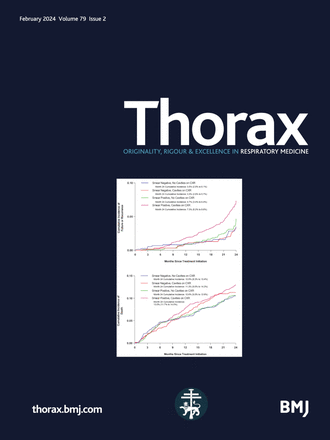Future risk projection to engage 'near-miss' individuals in lung cancer screening eligibility: an analysis of ILST data.
IF 7.7
1区 医学
Q1 RESPIRATORY SYSTEM
引用次数: 0
Abstract
INTRODUCTION Lung cancer risk increases with time, and participants who are initially ineligible for lung cancer screening (LCS) could become eligible later. The aim of this study was to determine the proportion of people (initially ineligible) who may become eligible in a risk model-based LCS programme and the impact smoking cessation could have on this cohort. METHODS All potential participants for the International Lung Screening Trial aged 55-80 years, ineligible for Low-dose CT screening at baseline (PLCOm2012<1.5% 6-year risk), were included. Assuming annual increments of change in age, smoking duration and quit time, and under the assumption of other risk variables being constant, projections of risk were made using the PLCOm2012 model from evaluation to the upper age limit of 80 years. RESULTS 4451 subjects with a median age of 61 (IQR: 57-66) years were included. Assuming no change in smoking status post evaluation, 2239 participants (50.3%) became eligible (PLCOm2012≥1.51%) by age 80, with 26.9% and 38.7% of the cohort reaching eligibility by age 70 and 75 years, respectively. Among participants with a baseline risk≥0.6%, 1518 (34.1%) reached eligibility within 10 years of initial evaluation. Smoking cessation after first evaluation can reduce the proportion of individuals who may become eligible for LCS by age 70 from 68.7% to 24.9%. CONCLUSIONS Future risk projection of eligibility could provide a time window for reassessment of risk on an individual level. It is important to provide smoking cessation services to individuals who are ineligible for LCS at the initial programme contact.在肺癌筛查资格中参与“险些”个体的未来风险预测:对ILST数据的分析
简介:肺癌风险会随着时间的推移而增加,最初不符合肺癌筛查(LCS)条件的参与者可能会在之后符合条件。本研究的目的是确定在基于风险模型的肺癌筛查计划中可能符合条件的人群(最初不符合条件)的比例,以及戒烟对这部分人群可能产生的影响。方法纳入所有 55-80 岁、基线时不符合低剂量 CT 筛查条件(PLCOm2012<1.5% 6 年风险)的国际肺癌筛查试验潜在参与者。假设年龄、吸烟时间和戒烟时间的变化每年递增,并假设其他风险变量不变,使用 PLCOm2012 模型预测了从评估到 80 岁年龄上限的风险。假设评估后吸烟状况无变化,2239 名受试者(50.3%)在 80 岁时符合条件(PLCOm2012≥1.51%),其中分别有 26.9% 和 38.7% 的受试者在 70 岁和 75 岁时符合条件。在基线风险≥0.6%的参与者中,有 1518 人(34.1%)在首次评估后的 10 年内符合条件。首次评估后戒烟可使 70 岁时符合 LCS 条件的人数比例从 68.7% 降至 24.9%。在最初接触项目时,为不符合长期服药资格的个体提供戒烟服务非常重要。
本文章由计算机程序翻译,如有差异,请以英文原文为准。
求助全文
约1分钟内获得全文
求助全文
来源期刊

Thorax
医学-呼吸系统
CiteScore
16.10
自引率
2.00%
发文量
197
审稿时长
1 months
期刊介绍:
Thorax stands as one of the premier respiratory medicine journals globally, featuring clinical and experimental research articles spanning respiratory medicine, pediatrics, immunology, pharmacology, pathology, and surgery. The journal's mission is to publish noteworthy advancements in scientific understanding that are poised to influence clinical practice significantly. This encompasses articles delving into basic and translational mechanisms applicable to clinical material, covering areas such as cell and molecular biology, genetics, epidemiology, and immunology.
 求助内容:
求助内容: 应助结果提醒方式:
应助结果提醒方式:


